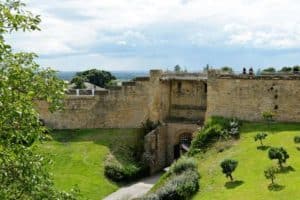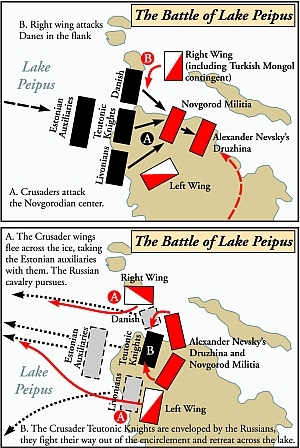5fish
Well-Known Member
- Joined
- Jul 28, 2019
- Messages
- 10,708
- Reaction score
- 4,559
I like to bring up battles throughout history that changed the course of a war, a civilization, of mankind or relevant in history...
I will pick the Battle of La Fobie... It was the death-nail to the Crusader states in the Levant. It will be the last time the Crusader states could put a large army in the field along with ending their offensive abilities as well. We all know the Battle of Hattin this battle really was the Crusaders Gettysburg marking their pick and the beginning of their decline. The battle of La Fobie left them open to being push into the sea which happens 50 or fewer years after the battle, in 1291 with the Siege of Acre by the Mamluks.
The Battle of LaFobie...
LINK:
Battle of La Forbie - Wikipedia
The Battle of La Forbie, also known as the Battle of Hiribya, was fought October 17, 1244 – October 18, 1244 between the allied armies (drawn from the Kingdom of Jerusalem, the crusading orders, the breakaway Ayyubids of Damascus, Homs and Kerak) and the Egyptian army of the Ayyubid Sultan as-Salih Ayyub, reinforced with Khwarezmian mercenaries.
Snip... the battle two days
Battle was joined on the morning October 17, with the Christian knights repeatedly charging the Egyptians and fighting up and down the line. The Egyptian army held its ground. On the morning of October 18, Baibars renewed the fight and threw the Khwarezmians against the Damascene troops in the center of the allied line. The center was shattered by their furious attack, after which they turned on the allied left and cut the Bedouin to pieces. The Emir's cavalry held stubbornly, but they were nearly annihilated; Al-Mansur finally rode from the field with 280 survivors, all that remained of his troops.
Threatened by the Egyptians in front and the Khwarezmians on their flank, the Crusaders charged the Mamluks facing them and were initially successful, pushing them back and causing Baibars some concern. Their assault gradually lost momentum as the Khwarezmid tribesmen attacked the rear and the flanks of the Christian forces, which were defended by disorganized infantry. The well-armed knights fought on doggedly and it took several hours for their resistance to collapse.[3]
Over 5,000 Crusaders died. 800 prisoners were taken, including Walter of Brienne, William of Chastelneuf, Master of the Hospital, and the Constable of Tripoli. Of the troops of the knightly orders, only 33 Templars, 27 Hospitallers and three Teutonic Knights survived; Philip of Montfort and the Patriarch of Jerusalem Robert of Nantes also escaped to Ascalon. However, Armand de Périgord, the Master of the Temple, the Marshal of the Temple, the archbishop of Tyre, the bishop of Lydda and Ramla (St. George), and John and William, sons of Bohemond, Lord of Botron, were all killed.
Snip...
Pope Innocent IV at the First Council of Lyon in 1245 called for a new Crusade, the seventh, but the Franks were never again to muster major power in the Holy Land. The Kingdom of Jerusalem suffered worst in the aftermath of La Forbie. It had not been able to put so large an army into the field since the Battle of Hattin, and would never be able to undertake offensive operations again. It brought no lasting success to the Ayyubids; the Khwarezmians were defeated outside Homs by Al-Mansur Ibrahim in 1246 after falling out with the Egyptians. Baibars (not to be confused with Al-Zahir Baibars who became a sultan), joined the Khwarezmians and was later arrested by as-Salih Ayyub and died in prison.
While the Battle of Hattin holds great symbolic importance as having led to the fall of Jerusalem, it was La Forbie that truly marked the collapse of Christian power in Outremer.
I will pick the Battle of La Fobie... It was the death-nail to the Crusader states in the Levant. It will be the last time the Crusader states could put a large army in the field along with ending their offensive abilities as well. We all know the Battle of Hattin this battle really was the Crusaders Gettysburg marking their pick and the beginning of their decline. The battle of La Fobie left them open to being push into the sea which happens 50 or fewer years after the battle, in 1291 with the Siege of Acre by the Mamluks.
The Battle of LaFobie...
LINK:
Battle of La Forbie - Wikipedia
The Battle of La Forbie, also known as the Battle of Hiribya, was fought October 17, 1244 – October 18, 1244 between the allied armies (drawn from the Kingdom of Jerusalem, the crusading orders, the breakaway Ayyubids of Damascus, Homs and Kerak) and the Egyptian army of the Ayyubid Sultan as-Salih Ayyub, reinforced with Khwarezmian mercenaries.
Snip... the battle two days
Battle was joined on the morning October 17, with the Christian knights repeatedly charging the Egyptians and fighting up and down the line. The Egyptian army held its ground. On the morning of October 18, Baibars renewed the fight and threw the Khwarezmians against the Damascene troops in the center of the allied line. The center was shattered by their furious attack, after which they turned on the allied left and cut the Bedouin to pieces. The Emir's cavalry held stubbornly, but they were nearly annihilated; Al-Mansur finally rode from the field with 280 survivors, all that remained of his troops.
Threatened by the Egyptians in front and the Khwarezmians on their flank, the Crusaders charged the Mamluks facing them and were initially successful, pushing them back and causing Baibars some concern. Their assault gradually lost momentum as the Khwarezmid tribesmen attacked the rear and the flanks of the Christian forces, which were defended by disorganized infantry. The well-armed knights fought on doggedly and it took several hours for their resistance to collapse.[3]
Over 5,000 Crusaders died. 800 prisoners were taken, including Walter of Brienne, William of Chastelneuf, Master of the Hospital, and the Constable of Tripoli. Of the troops of the knightly orders, only 33 Templars, 27 Hospitallers and three Teutonic Knights survived; Philip of Montfort and the Patriarch of Jerusalem Robert of Nantes also escaped to Ascalon. However, Armand de Périgord, the Master of the Temple, the Marshal of the Temple, the archbishop of Tyre, the bishop of Lydda and Ramla (St. George), and John and William, sons of Bohemond, Lord of Botron, were all killed.
Snip...
Pope Innocent IV at the First Council of Lyon in 1245 called for a new Crusade, the seventh, but the Franks were never again to muster major power in the Holy Land. The Kingdom of Jerusalem suffered worst in the aftermath of La Forbie. It had not been able to put so large an army into the field since the Battle of Hattin, and would never be able to undertake offensive operations again. It brought no lasting success to the Ayyubids; the Khwarezmians were defeated outside Homs by Al-Mansur Ibrahim in 1246 after falling out with the Egyptians. Baibars (not to be confused with Al-Zahir Baibars who became a sultan), joined the Khwarezmians and was later arrested by as-Salih Ayyub and died in prison.
While the Battle of Hattin holds great symbolic importance as having led to the fall of Jerusalem, it was La Forbie that truly marked the collapse of Christian power in Outremer.




